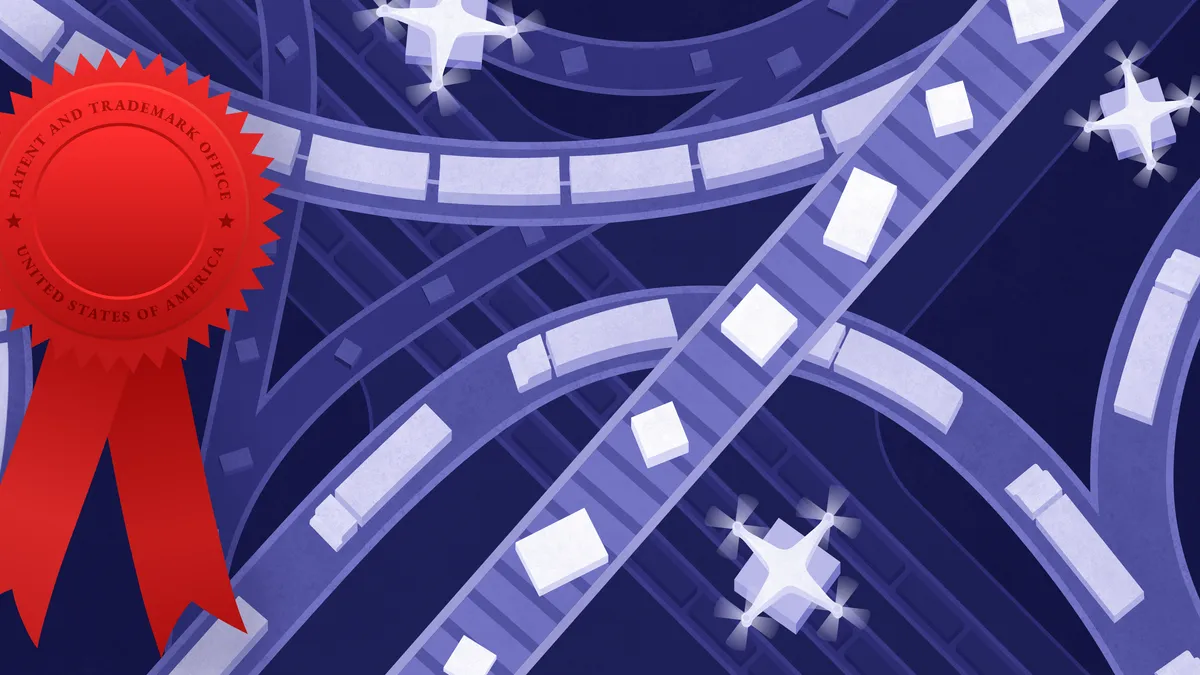This is Patent Pending. Supply chain-related patent applications are published every day and this is where we'll talk about the ones that could have the biggest impact on the supply chain and the ones that challenge the norm. We want to give you an idea of where supply chains are heading and what the industry is thinking. Read the previous issue here.
Wait your turn to dock

When trucks show up at a loading dock, they often follow the custom of "first-in first-out," or FIFO: The first truck to show up gets the loading dock. But this doesn't take into account the inventory in the trailers.
What if a trailer shows up full of a SKU that's out of stock in the distribution center? What if it's fruit with a time-sensitive delivery window?
One way to handle this would be to prioritize trailers for unloading based on what they're carrying rather than when they arrive, an idea that Walmart outlined in a patent published this week.
Multiple sensors would form a geofence around the yard or parking lot where trailers queue. The sensors would get information about what is inside of the trailer and either send it over a wireless communications network or directly to a "trailer assignment and prioritization system," according to the patent.
The prioritization system can then provide instructions to a driver through a phone or in-cab computer about which loading dock to use or in which parking spot to wait. Instructions could also be provided directly to an autonomous vehicle. When making the decision on whether to dock or park, the prioritization would consider the retailer's inventory system and what's in the trailer.
So, if a trailer is carrying fresh vegetables and the store is low on fresh vegetables, the trailer will be moved toward the top of the waiting list, the patent said.
Read up:
Smoke in the cockpit, fire in the sky

Carriers are occasionally asked to transport items that can be combustible. For example, a container onboard a Cosco ship carrying batteries caught fire earlier this year, according to The Maritime Executive.
Fires — or "environmental anomalies" as FedEx refers to them in a patent filed this week — need to be caught quickly. And the current method for monitoring containers for fire is insufficient with sensors too far from shipping containers, FedEx argued in its patent.
Any "delay in detecting such an environmental anomaly is inherently risky and adverse environmental conditions may rapidly intensify and spread so as to cause damage to the package, container, other packages in the container, other nearby containers, the transit vehicle transporting the container, the possible injury and loss of life to those operating the transit vehicle or manipulating the shipping container."
FedEx proposed placing multiple ID nodes within a container that would communicate with a fire suppression system via a wireless network. The system would interpret the signals from the nodes and deploy fire suppressing material as needed, the patent reads.
Read up:
The delivery is now floating your way

Using one larger vehicle as a launchpad for smaller autonomous vehicles is an idea that's been tossed around by many logistics companies from Amazon to UPS. Well, it turns out Uber has a plan, too, according to a patent published late last month by the Uber Advanced Technologies Center.
Uber's twist on the idea? Balloons.

The patent outlines a delivery system in which data encoded on packages set for delivery provide information on delivery location to an autonomous vehicle. The large autonomous vehicle, described in the patent as the "autonomous launch vehicle" would travel to a "general target location" where it would launch a smaller "autonomous delivery vehicle" to finish the delivery.
Uber explained that the system could work with airborne or land-based autonomous vehicles for the final leg of a delivery. But it specifically outlined one implementation in which a bladder is inflated with gas to lift the package from the launch vehicle. After the delivery vehicle deposits the package at the final location, the bladder could then be deflated.














